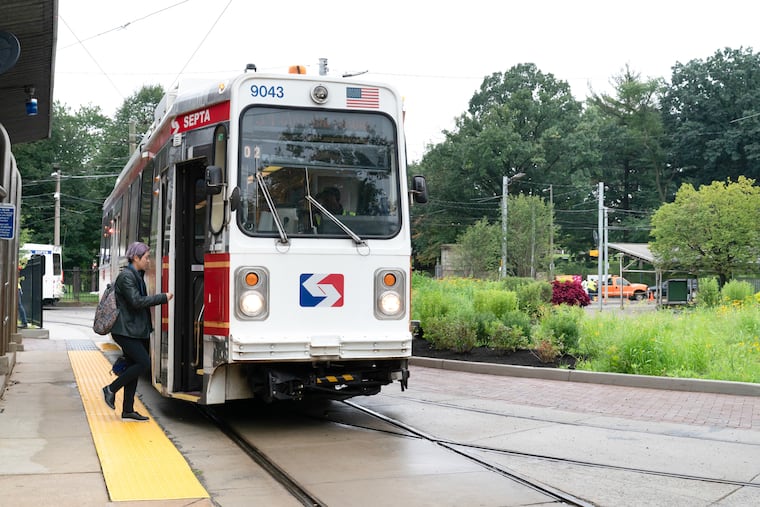Philly transit has great bones but could offer better service, one expert says
Philly's system could excel with more frequency, a transportation expert from Houston says.

The Philadelphia region has the bones of a great transit system, but one expert who recently looked at the region bemoaned what could be.
Christof Spieler, a former board member of Houston's transit authority, has a book out this year, Trains, Buses, and People: An Opinionated Atlas of US Transit, which looks at America's transportation networks with an eye to what works and what doesn't. Spieler was a driving force behind a major bus network redesign in Houston, which is serving as a model for a redesign now underway in Philadelphia. Houston's work was so influential that SEPTA hired the same consultant, Jarrett Walker.
Spieler's book reviews 47 urban areas nationwide, and his look at Philadelphia begins with the state of regional public transit just after the end of World War II, which he calls "spectacular." The Broad Street Line was the only four-track subway outside of New York City and one of two rail lines in the city. There was an expansive trolley network and commuter trains that reached the suburbs.
"The story since then has been one of decline," he writes.
>>READ MORE: SEPTA looks to Texas for ideas for bus route redesign
It's worth noting that Harrisburg's history of starving Philadelphia public transit of funds took a big turn in 2013 with the passage of Act 89, which created an oil company franchise tax that gives SEPTA about $350 million a year for capital projects. In 2022, though, SEPTA expects to face another funding challenge when the Pennsylvania Turnpike Commission's annual payment of $450 million to PennDot — a portion of which SEPTA relies on — will drop to $50 million a year.
His biggest criticism is SEPTA's lack of frequency. Cities like Denver and Salt Lake City have light rail that serves areas that are less densely populated than those along the Norristown High Speed Line and two suburban trolley lines here, but run more frequently and have more riders. The same criticism applies to the Regional Rail system.
"It's still a very traditional commuter-rail system," Spieler writes, "with infrequent midday, night, and weekend service, conductors collecting tickets, and separate fares from local transit."
He devotes attention to the shrinking trolley system, which once served 69 miles of track and now runs on just 30 miles. Philadelphia's network, the largest in the country with 80,000 riders every work day, exists because of the tunnel built from 1933 to 1956 giving trolley cars underground access from City Hall to University City. Trolleys can travel faster through the tunnel than vehicles on the roads above.
Spieler argues that SEPTA should bring back the Route 23 trolley. That route has been served by buses since 1992 and travels between Chestnut Hill and Center City along Germantown Avenue and 11th and 12th Streets. He says that route's ridership, about 17,600 a day, justifies streetcar service that runs more like the Market-Frankford Line than a bus route.
>>READ MORE: So long, 23 — the busiest and latest bus route
Fixed-route surface travel is tricky in Philadelphia. Riders on the Route 15 trolley along Girard Avenue know a single car parked too far from the curb can halt the service.
Many of Spieler's other recommendations, though, are under consideration. The transit agency has plans for a $1 billion overhaul by 2024, including new cars, platforms at stops, and more efficient service.
Changes planned for Regional Rail are in line with some of Spieler's recommendations. SEPTA is introducing the Key card to Regional Rail, allowing passengers to travel from bus to subway to commuter train with one fare card. SEPTA is expecting to begin receiving 45 new multi-level cars for Regional Rail next year. That will allow for schedule adjustments, but increased frequency depends on demand and staffing, officials have said.
On the New Jersey side of the river, Spieler describes PATCO as essential, but notes the River Line was ill-conceived from the beginning. The line, which runs from Camden to Trenton through some struggling waterfront towns, never was going to have the ridership to support new rail and was built largely to respond to political pressure for a rail line in South Jersey when NJ Transit had projects planned for the northern part of the state.
"So River Line is a poster child for where not to build rail," Spieler writes. "The places it serves simply don't have many people."
He does, though, credit the line for running frequent, consistent service, and notes that with about 9,000 boardings on the average weekday, the route is outperforming its ridership projections.